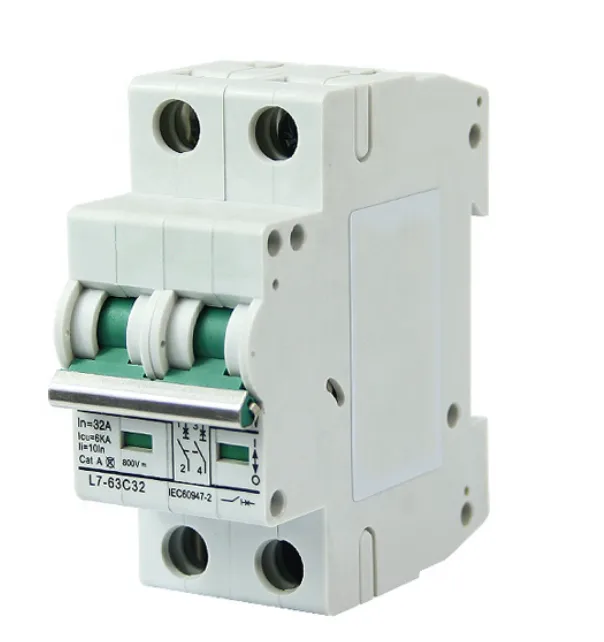Ar žinojote, kad elektros gedimai kasmet sukelia maždaug 131 TP3T visų gaisrų namuose? Kai jūsų miniatiūrinis jungiklis (MCB) nuolat suveikia, tai ne tik nepatogumas – tai jūsų namų elektros sistema, reikalaujanti dėmesio. Jūsų MCB skirtas apsaugoti jūsų turtą ir šeimą nuo elektros pavojų, todėl suprasti, kodėl jis nuolat išsijungia, yra labai svarbu jūsų saugumui.
Jei susiduriate su nuolatiniu automatinio jungiklio išsijungimu, greičiausiai esate nusivylę ir ieškote atsakymų. Perskaitę šį vadovą, tiksliai suprasite, kodėl jūsų automatinis jungiklis nuolat išsijungia, kada galite saugiai išspręsti problemą patys ir kada laikas kviesti profesionalų elektriką.
Kas yra MCB ir kodėl jis suveikia?
A miniatiūrinis grandinės pertraukiklis Automatinis elektros jungiklis (MCB) yra automatinis elektros jungiklis, skirtas apsaugoti jūsų namų elektros grandines nuo pažeidimų, kuriuos sukelia viršsrovis, trumpieji jungimai arba įžeminimo gedimai. Įsivaizduokite jį kaip savo elektros sistemos sargybinį – aptikęs potencialiai pavojingą situaciją, jis nedelsdamas nutraukia elektros tiekimą, kad išvengtų gaisrų, įrangos sugadinimo ar elektros smūgio.
Įprastomis aplinkybėmis automatinis jungiklis (MCB) turėtų suveikti retai. Retkarčiais suveikęs jungiklis per audras arba paleidžiant didelius prietaisus gali būti normalus, tačiau dažnas arba nuolatinis suveikimas rodo esminę elektros problemą, į kurią reikia atkreipti dėmesį.
Kai jūsų automatinis jungiklis nuolat suveikia, jis atlieka savo saugos funkciją, tačiau tai taip pat signalizuoja, kad jūsų elektros sistemoje reikia ką nors patikrinti.
#1 priežastis: grandinės perkrova
Dažniausia automatinių jungiklių suveikimo priežastis yra grandinės perkrova. Taip atsitinka, kai grandine teka didesnė elektros srovė, nei ji yra skirta saugiai atlaikyti.
Grandinės perkrovos požymiai
Grandinės perkrova dažnai rodo kelis įspėjamuosius ženklus prieš jūsų automatinio jungiklio suveikimą:
- Įjungus prietaisus, šviesos pritemsta
- Elektros lizdai šilti liesti
- Degimo kvapas šalia elektros skydinių ar lizdų
- Kištukai laisvai įkišami į lizdus
- Dažnas išsijungimas, kai vienu metu naudojami keli įrenginiai
Greitas sprendimas: apkrovos valdymo patarimai
Jei dėl grandinės perkrovos išsijungia automatinis jungiklis, išbandykite šiuos neatidėliotinus sprendimus:
- Perskirstyti elektros apkrovas atjungiant nebūtinus prietaisus ir paskirstant juos skirtingose grandinėse. Didelės galios prietaisai, tokie kaip šildytuvai, plaukų džiovintuvai ir dulkių siurbliai, idealiu atveju turėtų veikti tam skirtose grandinėse.
- Energiją eikvojančių įrenginių atpažinimas jūsų namuose. Dažniausios problemos priežastys yra elektriniai virduliai (1500 W), mikrobangų krosnelės (1000–1500 W) ir elektriniai šildytuvai (1500–2000 W). Venkite vienu metu jungti kelis didelės galios prietaisus prie tos pačios grandinės.
- Apskaičiuokite savo grandinės pajėgumąDauguma namų grandinių yra skirtos 15–20 amperų srovei. Paprasta nykščio taisyklė: neviršykite 80% grandinės vardinės galios esant nuolatinėms apkrovoms.
Kada atnaujinti elektros skydinę
Jei apkrovos valdymas neišsprendžia išjungimo problemos, gali tekti atnaujinti elektros skydinę. Apsvarstykite galimybę atnaujinti, jei jūsų namas buvo pastatytas iki 1990 m., jei, nepaisant tinkamo apkrovos valdymo, dažnai patiriate perkrovas arba planuojate įrengti didelius prietaisus ar priestatus.
#2 priežastis: trumpasis jungimas
Trumpasis jungimas įvyksta, kai elektros srovė nueina netikėtu keliu, beveik arba visiškai sukeldama varžą, ir sukelia staigų elektros šuolį, dėl kurio automatiškai suveikia automatinis jungiklis.
Kaip nustatyti trumpąjį jungimą
Trumpieji jungimai paprastai sukelia momentinį automatinio jungiklio suveikimą, kai tik jį iš naujo nustatote. Skirtingai nuo perkrovų, kurioms automatinio jungiklio suveikimas gali užtrukti kelias minutes, trumpieji jungimai sukelia momentinį atjungimą.
Ieškokite šių trumpojo jungimo požymių:
- Degimo kvapas arba matomi degimo žymės aplink lizdus ar prietaisus
- Apdegimo žymės ant elektros skydinių ar lizdų
- Kibirkščiavimas prijungiant įrenginius
- Automatinis jungiklis išsijungia iš karto po atstatymo
Dažnos priežastys
Trumpieji jungimai dažnai kyla dėl pažeistos laidų izoliacijos, kai tiesiogiai liečiasi įkaitę ir neutralūs laidai. Tai gali nutikti dėl graužikų padarytos žalos, senstančių laidų arba netinkamos elektros instaliacijos.
Sugedę prietaisai taip pat sukelia trumpuosius jungimus. Jei jūsų automatinis jungiklis suveikia tik tada, kai naudojate konkretų prietaisą, atjunkite tą prietaisą nuo elektros tinklo ir patikrinkite grandinę. Jei jungiklis nebesuveikia, prietaisas greičiausiai turi vidinių laidų problemų.
Pažeisti ilgintuvai arba maitinimo lizdai dažnai sukelia trumpuosius jungimus, ypač kai jie yra perkrauti, pažeisti arba netinkamai naudojami lauko sąlygomis.
Saugos įspėjimas: kada NEDARYTI „pasidaryk pats“
Trumpieji jungimai kelia rimtą pavojų saugumui. Niekada nebandykite patys taisyti įtariamų trumpųjų jungimų. Jei įtariate trumpąjį jungimą, išjunkite elektros tiekimą pažeistoje zonoje ir nedelsdami kreipkitės į kvalifikuotą elektriką.
Bandant patiems taisyti trumpuosius jungimus, galima patirti elektros smūgį, nudegimus ar gaisrą. Profesionalūs elektrikai turi įrankių ir patirties, kad galėtų saugiai diagnozuoti ir pašalinti trumpųjų jungimų problemas.
#3 priežastis: Įžeminimas
Įžeminimo gedimai įvyksta, kai elektra nuklysta nuo numatyto kelio ir per vandenį, žmogų ar sugedusią įrangą patenka į žemę. Tai sukuria pavojingą situaciją, kuri gali sukelti elektros smūgį.
Įžeminimo gedimų ir trumpųjų jungimų supratimas
Nors abu šie gedimai sukelia automatinių jungiklių suveikimą, įžeminimo gedimai yra susiję su elektros srove, tekančia į žemę, o ne tarp įžemintų ir nulinių laidų. Įžeminimo gedimai yra ypač pavojingi, nes jie gali sukelti elektros smūgį, jei pateksite į elektros srovę, kuri veda į žemę.
Šiuolaikiniuose namuose įžeminimo grandinės pertraukikliai (GFCI) naudojami tose vietose, kur gali liestis vanduo ir elektra. Tačiau senesni automatiniai jungikliai be GFCI apsaugos vis tiek gali suveikti įžeminimo gedimo atveju.
Didelės rizikos zonos
Įžeminimo gedimai dažniausiai pasitaiko drėgnose vietose:
- Vonios kambariai kelia didelį pavojų dėl vandens ir elektros prietaisų derinio. Plaukų džiovintuvai, elektriniai skustuvai ir kiti vonios kambario prietaisai gali sukelti įžeminimo gedimus, jei atsiranda vidinių problemų arba jie liečiasi su vandeniu.
- Virtuvės turėti kelis vandens šaltinius ir elektros prietaisus. Indaplovės, šiukšlių smulkintuvai ir smulkūs prietaisai šalia kriauklių yra dažni įžeminimo gedimų šaltiniai.
- Lauko lizdai susiduria su oro sąlygų poveikiu, kuris gali sukelti įžeminimus. Lietus, laistymo sistemos ir didelė drėgmė gali prisidėti prie įžeminimų susidarymo.
- Rūsiai ir pogrindinės erdvės dažnai kyla drėgmės problemų, kurios gali sukelti įžeminimo gedimus elektros sistemose.
GFCI apsaugos svarba
Jei jūsų automatinis jungiklis nuolat išsijungia dėl įžeminimo gedimų, būtina atnaujinti į GFCI apsaugą. GFCI įtaisai aptinka įžeminimo gedimus per milisekundes ir atjungia maitinimą, kol dar neįvyko pavojingas elektros smūgis.
Šiuolaikiniai elektros kodeksai reikalauja GFCI apsaugos vonios kambariuose, virtuvėse, lauko zonose, rūsiuose ir kitose didelės rizikos vietose.
#4 priežastis: sugedęs arba senstantis automatinis jungiklis
Kartais problema slypi ne jūsų elektros sistemoje, o pačiame automatiniame jungiklie (MCB). Laikui bėgant, automatiniai jungikliai gali susidėvėti, tapti pernelyg jautrūs ir be reikalo išsijungti.
Požymiai, kad reikia pakeisti jūsų automatinį jungiklio jungiklį
Senstantys MCB dažnai pasižymi būdingais simptomais:
- Išjungimas esant apkrovoms, gerokai mažesnėms už vardinę keliamąją galią
- Sunku iš naujo nustatyti pertraukiklį
- Jungiklis karštas liečiant
- Matomos korozijos arba degimo žymės ant jungiklio
- Jungiklis nelieka „įjungtoje“ padėtyje
Vidutinė grandinės pertraukiklių tarnavimo trukmė
Kokybiški automatiniai jungikliai normaliomis sąlygomis paprastai tarnauja 25–40 metų. Tačiau tokie veiksniai kaip dažni cikliniai perjungimai, elektros viršįtampiai ir aplinkos sąlygos gali gerokai sutrumpinti jų tarnavimo laiką.
Jei jūsų namų elektros skydinė yra senesnė nei 20 metų ir dažnai išjungiate elektros srovę, kaltininkai gali būti senstantys elektros grandinės pertraukikliai.
Profesionalūs įrengimo reikalavimai
Automatinio jungiklio keitimas reikalauja darbų elektros skydinės viduje, o tai kelia rimtą pavojų saugai. Šį darbą visada turėtų atlikti licencijuoti elektrikai, kurie gali užtikrinti tinkamą montavimą ir atitiktį elektros kodeksams.
Netinkamas automatinio jungiklio įrengimas gali sukelti gaisrą, elektros smūgį arba sistemos gedimus, kurie kelia pavojų jūsų namams ir šeimai.
#5 priežastis: Atsilaisvinusios elektros jungtys
Atsilaisvinusios elektros jungtys sukuria varžą, kuri generuoja šilumą ir gali sukelti automatinių jungiklių suveikimą. Ši problema dažnai vystosi palaipsniui ir laikui bėgant gali pablogėti.
Kaip laisvos jungtys sukelia išjungimą
Kai elektros jungtys atsilaisvina, jos sukuria varžos taškus, kurie generuoja perteklinę šilumą. Dėl šios šilumos gali suveikti automatiniai jungikliai, kurie veikia kaip apsaugos priemonė, net kai faktinė elektros apkrova yra normaliose ribose.
Laisvi ryšiai dažniausiai susidaro:
- Vielinės veržlės skirstomosiose dėžutėse
- Jungtys prie lizdų ir jungiklių
- Skydinės jungtys, kur laidai jungiasi prie jungiklių
- Aptarnavimo įėjimo jungtys
Įspėjamieji ženklai, į kuriuos reikia atkreipti dėmesį
Atsilaisvinusios jungtys dažnai sukelia įspėjamuosius ženklus prieš sukeldamos automatinio jungiklio išjungimą:
- Mirksinčios lemputės, ypač įjungus prietaisus
- Degimo kvapas šalia elektrinių komponentų
- Šilti arba karšti lizdų dangteliai, jungiklių plokštės arba skydelių dangteliai
- Traškesio arba šnypštimo garsai iš elektros komponentų
- Periodinis elektros energijos tiekimo sutrikimas tam tikrose vietose
Kodėl tai reikalauja profesionalo dėmesio
Atsilaisvinusios elektros jungtys kelia rimtą gaisro pavojų ir niekada neturėtų būti ignoruojamos. Atsilaisvinusių jungčių susidariusi šiluma gali uždegti aplinkines medžiagas ir sukelti gaisrą namuose.
Profesionalūs elektrikai turi patirties saugiai surasti ir sutaisyti atsilaisvinusias jungtis visoje jūsų elektros sistemoje. Jie taip pat gali nustatyti galimas jungčių problemas, kol jos netapo pavojingos.
Kaip saugiai pašalinti MCB išjungimo triktis
Prieš skambindami elektrikui, galite atlikti keletą pagrindinių trikčių šalinimo veiksmų, kurie padės nustatyti problemą:
- 1 žingsnis: Pirmiausia saugumas Prieš bandydami pašalinti triktis, išjunkite ir atjunkite visus prietaisus nuo paveiktos grandinės. Niekada nedirbkite su elektros sistemomis šlapiomis rankomis arba stovėdami ant šlapių paviršių.
- 2 veiksmas: nustatykite modelį Atkreipkite dėmesį, kada suveikia automatinis jungiklis. Ar tai įvyksta iš karto, kai jį nustatote iš naujo, ar tik naudojant tam tikrus prietaisus? Ar tai įvyksta tam tikru paros metu arba atliekant tam tikrą veiklą?
- 3 veiksmas: patikrinkite, ar nėra akivaizdžių problemų Ieškokite matomų pažeidimo požymių, tokių kaip degimo žymės, išsilydęs plastikas ar neįprasti kvapai aplink lizdus, jungiklius ir prietaisus.
- 4 veiksmas: išbandykite atskirus įrenginius Jei automatinis jungiklis suveikia tik naudojant konkrečius prietaisus, patikrinkite tuos prietaisus skirtingose grandinėse, kad nustatytumėte, ar problema yra prietaise, ar grandinėje.
- 5 veiksmas: nustatykite iš naujo ir stebėkite Įsitikinę, kad visi įrenginiai atjungti, nustatykite automatinį jungiklį į pradinę padėtį. Jei jis toliau įjungtas, nors nėra prijungtų apkrovų, palaipsniui prijunkite įrenginius po vieną, kad nustatytumėte, kuris iš jų išprovokavo išsijungimą.
Kada kreiptis į profesionalų elektriką
Tam tikros situacijos reikalauja neatidėliotinos profesionalios pagalbos ir niekada neturėtų būti sprendžiamos „pasidaryk pats“ metodais:
- Reikalinga skubi profesionali pagalba:
- Automatinis jungiklis išsijungia iš karto po atstatymo, net ir neprijungus apkrovų
- Matomi nudegimo žymės, išsilydęs plastikas arba gaisro padaryta žala aplink elektros komponentus
- Deginimo kvapas, kuris išlieka ir išjungus maitinimą
- Bet kokie kibirkščių ar elektros lanko požymiai
- MCB karštas liečiant
- Jums nepatogu atlikti bet kokius elektros gedimų šalinimo veiksmus
- Elektros darbai, kuriems reikalingas profesionalus licencijavimas:
- Automatinio jungiklio keitimas arba elektros skydinės darbai
- Naujų grandinių ar lizdų įrengimas
- Pažeistų laidų remontas sienų viduje
- Elektros instaliacijos ar skydinių atnaujinimas
- Bet kokie darbai, susiję su pagrindine jūsų namų elektros instaliacija
Kvalifikuoto elektriko pasirinkimas:
Ieškokite elektrikų, turinčių licenciją jūsų vietovėje, turinčių atitinkamą draudimą ir pateikiančių rekomendacijas iš neseniai užsiregistravusių klientų. Gaukite kelias sąmatas dideliems elektros darbams ir įsitikinkite, kad visiems darbams atlikti yra gauti atitinkami leidimai, kai to reikalaujama.
Būsimų MCB išjungimo problemų prevencija
Proaktyvi elektros priežiūra gali padėti išvengti daugelio automatinių jungiklių išjungimo problemų:
-
- Reguliarus elektros įrangos aptarnavimas:
- Kas 5–10 metų kreipkitės į kvalifikuotą elektriką, kad patikrintų jūsų elektros sistemą
- Kas mėnesį patikrinkite GFCI lizdus naudodami bandymo ir atstatymo mygtukus
- Laikykite elektros skydines švarias nuo laikomų daiktų ir užtikrinkite lengvą prieigą prie jų.
- Nedelsdami pakeiskite pažeistus ilgintuvus ir maitinimo laidus
- Elektros saugos geriausios praktikos:
- Venkite grandinių perkrovimo per dideliu įrenginių skaičiumi
- Naudokite tinkamus ilgintuvus lauko darbams
- Laikykite elektros prietaisus atokiau nuo vandens šaltinių
- Įrenkite vertingos elektronikos viršįtampių apsaugas
- Didelės rizikos zonose atnaujinkite lizdus, kad jie būtų apsaugoti nuo gedimų (GFCI)
- Reguliarus patikrinimų grafikas:
- Reguliarus elektros įrangos aptarnavimas:
Kas mėnesį atlikite elektros lizdų, jungiklių ir skydo vizualinę apžiūrą. Ieškokite pažeidimų, neįprasto karščio ar kitų problemų, kurios gali rodyti kylančias elektros problemas.
Planuokite profesionalias elektros instaliacijos patikras kas 5–10 metų arba nedelsdami, jei pastebite kokių nors nerimą keliančių simptomų.
Išvada
Suprasti, kodėl jūsų automatinis jungiklis nuolat išsijungia, yra labai svarbu norint užtikrinti saugią namų elektros sistemą. Penkios dažniausios priežastys – grandinės perkrova, trumpieji jungimai, įžeminimo gedimai, sugedę automatiniai jungikliai ir atsilaisvinusios jungtys – reikalauja skirtingų sprendimo būdų.
Nors kai kurie pagrindiniai trikčių šalinimo būdai gali padėti nustatyti problemą, atminkite, kad elektros darbai kelia rimtą pavojų saugumui. Kilus abejonių, visada pasitarkite su kvalifikuotu elektriku. Jūsų šeimos saugumas yra daug vertingesnis nei profesionalių elektros paslaugų kaina.
Jei jūsų automatinis jungiklis ir toliau suveikia po pagrindinio trikčių šalinimo, neignoruokite problemos. Susisiekite su licencijuotu elektriku, kad jis tinkamai diagnozuotų ir pašalintų problemą. Atminkite: sugedęs automatinis jungiklis yra jūsų elektros sistemos būdas jus apsaugoti – įsiklausykite į jo signalus ir imkitės atitinkamų veiksmų, kad jūsų namai būtų saugūs.
Susijęs
Kaip išsirinkti tinkamą nuolatinės srovės jungiklį | Eksperto pasirinkimo vadovas
Kas yra nuolatinės srovės grandinės pertraukiklis
Kaip pasirinkti tinkamą miniatiūrinį grandinės pertraukiklį: Visą techninį vadovą.



